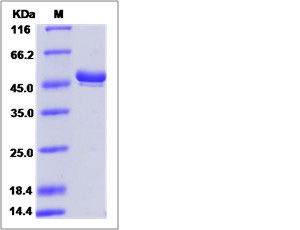Rat SerpinF1 / PEDF Protein (His Tag)
Dmrs91
- 100ug (NPP3121) Please inquiry
| Catalog Number | P80481-R08H |
|---|---|
| Organism Species | Rat |
| Host | Human Cells |
| Synonyms | Dmrs91 |
| Molecular Weight | The recombinant rat Serpinf1 consists 410 amino acids and predicts a molecular mass of 45.9 kDa. |
| predicted N | Gln 20 |
| SDS-PAGE |  |
| Purity | > 90 % as determined by SDS-PAGE. |
| Protein Construction | A DNA sequence encoding the rat Serpinf1 (NP_808788.1) (Met1-Thr418) was expressed with a polyhistidine tag at the C-terminus. |
| Bio-activity | |
| Research Area | Developmental Biology |Organogenesis |Skeletal development |Other Bone Remodeling Molecules |
| Formulation | Lyophilized from sterile PBS, pH 7.4. 1. Normally 5 % - 8 % trehalose and mannitol are added as protectants before lyophilization. Specific concentrations are included in the hardcopy of COA. |
| Background | Pigment epithelium-derived factor, also known as PEDF, Serpin F1, and SERPINF1, is a multiple functional protein which has both anti-angiogenic activity and neurotrophic activity at the same time. PEDF is a secreted glycoprotein that belongs to the noninhibitory serpin. It has an alpha/beta core serine-protease inhibitor domain, three major beta-sheets, and ten alpha-helices. PEDF does not inhibit either serine or cysteine proteinases. PEDF exerts diverse physiological activities including anti-angiogenesis, anti-vasopermeability, anti-tumor, and neurotrophic activities. PEDF acts via multiple high affinity ligands and cell receptors. It has been described as a natural angiogenesis inhibitor with neurotrophic and immune-modulation properties. PEDF induces macrophages apoptosis and necrosis through the activation of peroxisome proliferator-activated receptor-gamma by which PEDF could modulate inflammatory reactions in septic shock. It balances angiogenesis in the eye and blocks tumor progression. |
| Reference |
